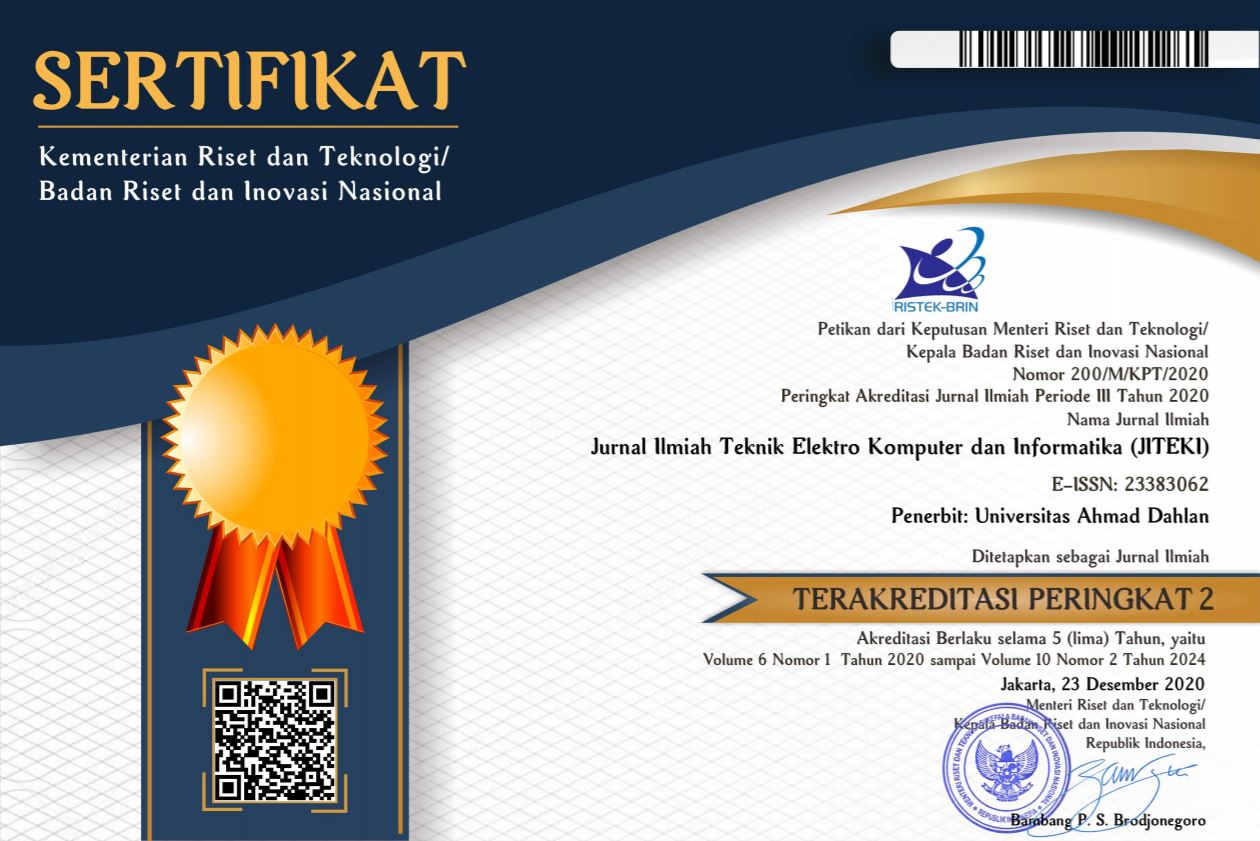
The Development of Real-Time Mobile Garbage Detection Using Deep Learning
Abstract
Keywords
Full Text:
PDFReferences
C. Ellis, “World Bank: Global waste generation could increase 70% by 2050,†WasteDive, 2018. https://www.wastedive.com/news/world-bank-global-waste-generation-2050/533031/ (accessed Nov. 17, 2021).
S. Sambaraju and V. Sree Lakshmi, “Eco-friendly treatment of dairy wastewater using garbage enzyme,†Mater. Today Proc., vol. 33, pp. 650–653, 2020. https://doi.org/10.1016/j.matpr.2020.05.719
S. Negi, A. Mandpe, A. Hussain, and S. Kumar, “Collegial effect of maggots larvae and garbage enzyme in rapid composting of food waste with wheat straw or biomass waste,†J. Clean. Prod., vol. 258, p. 120854, Jun. 2020. https://doi.org/10.1016/j.jclepro.2020.120854
W.-L. Mao, W.-C. Chen, C.-T. Wang, and Y.-H. Lin, “Recycling waste classification using optimized convolutional neural network,†Resour. Conserv. Recycl., vol. 164, p. 105132, 2021. https://doi.org/10.1016/j.resconrec.2020.105132
M. Toğaçar, B. Ergen, and Z. Cömert, “Waste classification using AutoEncoder network with integrated feature selection method in convolutional neural network models,†Measurement, vol. 153, p. 107459, Mar. 2020. https://doi.org/10.1016/j.measurement.2019.107459
O. Adedeji and Z. Wang, “Intelligent waste classification system using deep learning convolutional neural network,†Procedia Manuf., vol. 35, pp. 607–612, 2019. https://doi.org/10.1016/j.promfg.2019.05.086
V. Punitha and C. Mala, “Traffic classification for connectionless services with incremental learning,†Comput. Commun., vol. 150, pp. 185–199, Jan. 2020. https://doi.org/10.1016/j.comcom.2019.11.017
C. Zhang, X. Zhang, D. Tu, and Y. Wang, “Small object detection using deep convolutional networks: applied to garbage detection system,†J. Electron. Imaging, vol. 30, no. 04, Aug. 2021. https://doi.org/10.1117/1.JEI.30.4.043013
Z. Yang and J. Chang, “A multi-attribute decision-making-based site selection assessment algorithm for garbage disposal plant using interval q-rung orthopair fuzzy power Muirhead mean operator,†Environ. Res., vol. 193, p. 110385, Feb. 2021. https://doi.org/10.1016/j.envres.2020.110385
W. Chen, H. Wang, H. Li, Q. Li, Y. Yang, and K. Yang, “Real-Time Garbage Object Detection With Data Augmentation and Feature Fusion Using SUAV Low-Altitude Remote Sensing Images,†IEEE Geosci. Remote Sens. Lett., pp. 1–5, 2021. https://doi.org/10.1109/LGRS.2021.3074415
M. U. Sohag and A. K. Podder, “Smart garbage management system for a sustainable urban life: An IoT based application,†Internet of Things, vol. 11, p. 100255, Sep. 2020. https://doi.org/10.1016/j.iot.2020.100255
D. Abuga and N. . Raghava, “Real-time smart garbage bin mechanism for solid waste management in smart cities,†Sustain. Cities Soc., vol. 75, p. 103347, Dec. 2021. https://doi.org/10.1016/j.scs.2021.103347
C. Wang, J. Qin, C. Qu, X. Ran, C. Liu, and B. Chen, “A smart municipal waste management system based on deep-learning and Internet of Things,†Waste Manag., vol. 135, no. August, pp. 20–29, 2021. https://doi.org/10.1016/j.wasman.2021.08.028
T. Urbanczyk and L. Peter, “Database Development for the Urgent Department of Hospital based on Tagged Entity Storage Following the IoT Concept,†IFAC-PapersOnLine, vol. 49, no. 25, pp. 278–283, 2016. https://doi.org/10.1016/j.ifacol.2016.12.047
C.-Y. Huang and Y.-J. Chang, “An adaptively multi-attribute index framework for big IoT data,†Comput. Geosci., vol. 155, p. 104841, Oct. 2021. https://doi.org/10.1016/j.cageo.2021.104841
Y. Chen, J. Nakazawa, T. Yonezawa, and H. Tokuda, “Cruisers: An automotive sensing platform for smart cities using door-to-door garbage collecting trucks,†Ad Hoc Networks, vol. 85, pp. 32–45, Mar. 2019. https://doi.org/10.1016/j.adhoc.2018.10.018
R. Abishega, S. Saranya, M. Devayani, C. P. Subiksha, and G. Sudha, “Driverless vehicle for garbage collection,†Mater. Today Proc., Mar. 2021. https://doi.org/10.1016/j.matpr.2021.01.044
S. Parasuraman, A. Sam, S. K. Yee, B. C. Chuon, and L. Ren, “Smartphone usage and increased risk of mobile phone addiction: A concurrent study,†Int. J. Pharm. Investig., vol. 7, no. 3, p. 125, 2017. https://doi.org/10.4103/jphi.JPHI_56_17
S. Köse and M. Murat, “Examination of the relationship between smartphone addiction and cyberchondria in adolescents,†Arch. Psychiatr. Nurs., vol. 35, no. 6, pp. 563–570, Dec. 2021. https://doi.org/10.1016/j.apnu.2021.08.009
M. Yang and G. Thung, “Classification of Trash for Recyclability Status,†pp. 1–6, 2016. https://doi.org/10.1145/2971648.2971731
S. López-Tapia, R. Molina, and A. K. Katsaggelos, “Deep learning approaches to inverse problems in imaging: Past, present and future,†Digit. Signal Process., vol. 119, p. 103285, Dec. 2021. https://doi.org/10.1016/j.dsp.2021.103285
A. Krizhevsky, I. Sutskever, and G. E. Hinton, “ImageNet classification with deep convolutional neural networks,†Communications of the ACM, vol. 60, no. 6, pp. 84–90, May 2017. https://doi.org/10.1145/3065386
C. Szegedy et al., “Going deeper with convolutions,†in Proceedings of the IEEE Computer Society Conference on Computer Vision and Pattern Recognition, 2015, vol. 07-12-June, pp. 1–9. https://doi.org/10.1109/CVPR.2015.7298594
G. Huang, Z. Liu, L. Van Der Maaten, and K. Q. Weinberger, “Densely connected convolutional networks,†in Proceedings - 30th IEEE Conference on Computer Vision and Pattern Recognition, CVPR 2017, 2017, vol. 2017-Janua, pp. 2261–2269. https://doi.org/10.1109/CVPR.2017.243
W. Liu et al., “SSD: Single shot multibox detector,†Lect. Notes Comput. Sci. (including Subser. Lect. Notes Artif. Intell. Lect. Notes Bioinformatics), vol. 9905 LNCS, pp. 21–37, 2016. https://doi.org/10.1007/978-3-319-46448-0_2
J. Redmon and A. Farhadi, “YOLOv3: An Incremental Improvement,†arXiv preprint arXiv:1804.02767 2018, [Online]. Available: http://arxiv.org/abs/1804.02767
S. Ren, K. He, R. Girshick, and J. Sun, “Faster R-CNN: Towards Real-Time Object Detection with Region Proposal Networks,†IEEE Trans. Pattern Anal. Mach. Intell., vol. 39, no. 6, pp. 1137–1149, 2017. https://doi.org/10.1109/TPAMI.2016.2577031
W. L. Mao, H. I. K. Fathurrahman, Y. Lee, and T. W. Chang, “EEG dataset classification using CNN method,†in Journal of physics: conference series, 2020, vol. 1456, no. 1, p. 12017. https://doi.org/10.1088/1742-6596/1456/1/012017
A. Lambora, K. Gupta, and K. Chopra, “Genetic Algorithm- A Literature Review,†Proc. Int. Conf. Mach. Learn. Big Data, Cloud Parallel Comput. Trends, Prespectives Prospect. Com. 2019, no. 1998, pp. 380–384, 2019. https://doi.org/10.1109/COMITCon.2019.8862255
S. Meng and W. -T. Chu, “A Study of Garbage Classification with Convolutional Neural Networks,†2020 Indo – Taiwan 2nd International Conference on Computing, Analytics and Networks (Indo-Taiwan ICAN), 2020, pp. 152-157. https://doi.org/10.1109/Indo-TaiwanICAN48429.2020.9181311
C. Bircanoglu, M. Atay, F. Beser, O. Genc, and M. A. Kizrak, “RecycleNet: Intelligent Waste Sorting Using Deep Neural Networks,†2018 IEEE Int. Conf. Innov. Intell. Syst. Appl. INISTA 2018, 2018. https://doi.org/10.1109/INISTA.2018.8466276
Kissablemt, “InceptionV3 Fine-tuning [97%] | Kaggle,†2020. https://www.kaggle.com/kissablemt/inceptionv3-fine-tuning-97 (accessed Apr. 16, 2020).
R. A. Aral, S. R. Keskin, M. Kaya, and M. Haciömeroǧlu, “Classification of TrashNet Dataset Based on Deep Learning Models,†Proc. - 2018 IEEE Int. Conf. Big Data, Big Data 2018, pp. 2058–2062, 2019. https://doi.org/10.1109/BigData.2018.8622212
DOI: http://dx.doi.org/10.26555/jiteki.v7i3.22295
Refbacks
- There are currently no refbacks.
Copyright (c) 2022 Haris Imam Karim Fathurrahman, Alfian Ma'arif, Li-Yi Chin

This work is licensed under a Creative Commons Attribution-ShareAlike 4.0 International License.
| About the Journal | Journal Policies | Author | Information |
Organized by Electrical Engineering Department - Universitas Ahmad Dahlan
Published by Universitas Ahmad Dahlan
Website: http://journal.uad.ac.id/index.php/jiteki
Email 1: jiteki@ee.uad.ac.id



